Successful combat operations in urban areas require skills that are unique to
this type of fighting. This appendix discusses some of those skills. For a more
detailed discussion, see FM
90-10-1.
Movement in urban areas is a fundamental skill that you must master. To
minimize exposure to enemy fire while moving:
Always cross a wall rapidly. But first, find a low spot to cross and visually
reconnoiter the other side of the wall to see if it is clear of obstacles and
the enemy. Next, quickly roll over the wall, keeping a low silhouette. The rapid
movement and low silhouette keep the enemy from getting a good shot at you.
Before moving around a corner, check out the area beyond it to see if it is
clear of obstacles and the enemy. Do not expose yourself when checking out that
area. Lie flat on the ground and do not expose your weapon beyond the corner.
With your steel helmet on, look around the corner at ground level only enough to
see around it. Do not expose your head any more than necessary. If there are no
obstacles or enemy present, stay low and move around the corner.
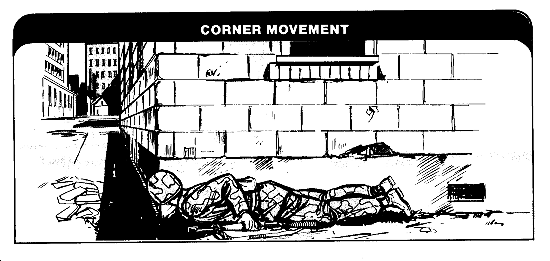
HOW TO MOVE PAST A WINDOW
When moving past a window on the first floor of a building, stay below the
window level. Take care not to silhouette yourself in the window, and stay close
to the side of the building.
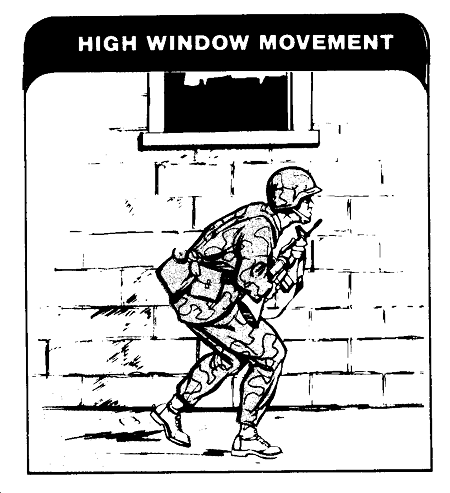
When moving past a window in a basement, use the same basic techniques used
in passing a window on the first floor. However, instead of staying below the
window, step or jump over it without exposing your legs.
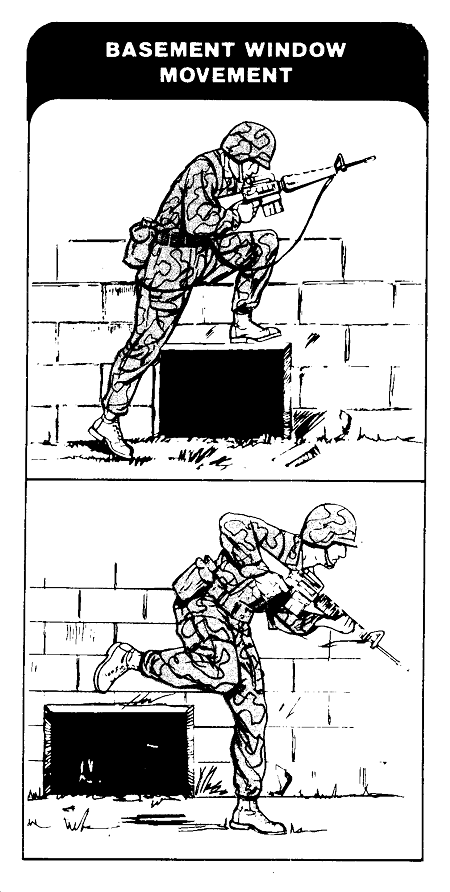
HOW TO MOVE PARALLEL TO A BUILDING
When you must move parallel to a building, use smoke for concealment and have
someone to overwatch your move. Stay close to the side of the building. Use
shadows if possible, and stay low. Move quickly from covered position to covered
position.
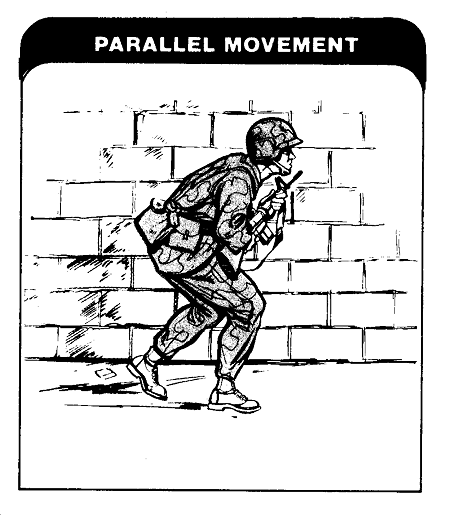
HOW TO CROSS OPEN AREAS
Whenever possible, you should avoid kill zones such as streets, alleys, and
parks. They are natural kill zones for enemy machine guns. When you must cross
an open area, do it quickly. Use the shortest route across the area. Use smoke
to conceal your move and have someone overwatch you.
If you must go from point A to point C, as depicted in the illustration, do
not move from point A straight to point C. This is the longest route across the
open area and gives the enemy more time to track and hit you.
Instead of going from point A straight to point C, select a place (point B)
to move to, using the shortest route across the open area.
Once on the other side of the open area, move to point C using the techniques
already discussed.
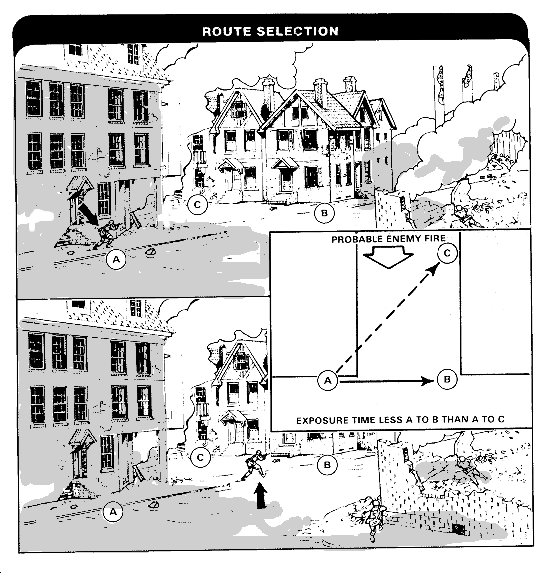
HOW TO MOVE IN A BUILDING
When moving in a building, do not silhouette yourself in doors and windows.
Move past them as discussed for outside movement.
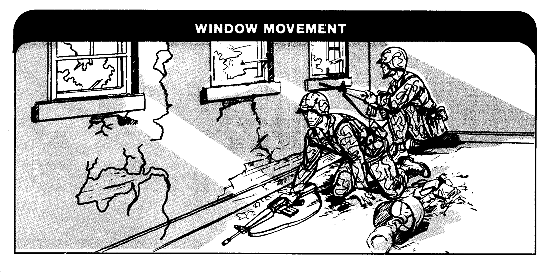
If forced to use a hallway, do not present a large target to the enemy. Hug
the wall and get out of the hallway quickly.

HOW TO ENTER A BUILDING
When entering a building, take every precaution to get into it with minimum
exposure to enemy fire and observation. Some basic rules are:
-
Select an entry point before moving.
-
Avoid windows and doors.
-
Use smoke for concealment.
-
Make new entry points by using demolitions or tank rounds.
-
Throw a hand grenade through the entry point before entering.
-
Quickly follow the explosion of the hand grenade.
-
Have your buddy overwatch you as you enter the building.
-
Enter at the highest level possible.
HIGH LEVEL ENTRIES
The preferred way to clear a building is to clear from the top down. That is
why you should enter at the highest level possible. If a defending enemy is
forced down to the ground level, he may leave the building, thus exposing
himself to the fires outside the building.

If the enemy is forced up to the top floor, he may fight even harder than
normal or escape over the roofs of other buildings.
You can use ropes, ladders, drain pipes, vines, helicopters, or the roofs and
windows of adjoining buildings to reach the top floor or roof of a building. In
some cases, you can climb onto another soldier's shoulders and pull yourself up.
You can attach a grappling hook to one end of a rope and throw the hook to the
roof, where it can snag something to hold the rope in place.

LOW LEVEL ENTRIES
There will be times when you can't enter from an upper level or the roof. In
such cases, entry at the ground floor may be your only way to get into the
building. When making low level entries, avoid entries through windows and doors
as much as possible. They are often booby trapped and are probably covered by
enemy fire.
When making low level entries, use demolitions, artillery, tanks, antitank
weapons, or similar means to make an entry point in a wall. Before entering the
entry point, throw a cooked-off hand grenade through the entry point to
reinforce the effects of the first blast.
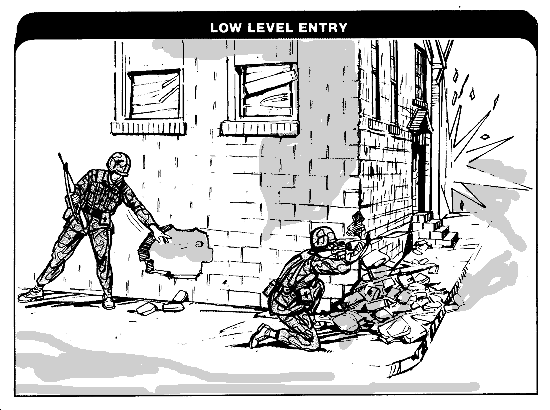
HOW TO USE HAND GRENADES
When fighting in built-up areas, use hand grenades to clear rooms, hallways,
and buildings. Throw a hand grenade before entering a door, window, room, hall,
stairwell, or any other entry point. Before throwing a hand grenade, let it cook
off for 2 seconds. That keeps the enemy from throwing it back before it
explodes.
To cook off a hand grenade remove your thumb from the safety lever; allow the
lever to rotate out and away from the grenade; then count one thousand one, one
thousand two, and throw it.
The best way to put a grenade into an upper-story opening is to use a grenade
launcher.
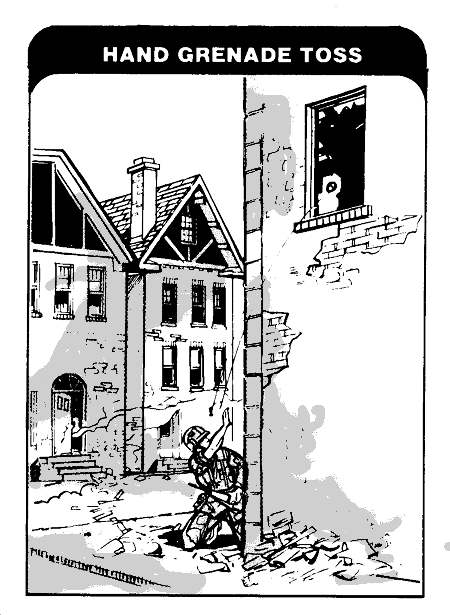
When you throw a hand grenade into an opening, stay close to the building,
using it for cover. Before you throw the hand grenade, select a safe place to
move to in case the hand grenade does not go into the opening or in case the
enemy throws it back. Once you throw the hand grenade, take cover. After the
hand grenade explodes, move into the building quickly.
HOW TO USE FIGHTING POSITIONS
Fighting positions in urban areas are different from those in other types of
terrain. They are not always prepared as discussed in chapter
2. In some cases, you must use hasty fighting positions which are
no more than whatever cover is available.
CORNERS OF BUILDINGS
When using a corner of a building as a fighting position, you must be able to
fire from either shoulder. Fire from the shoulder that lets you keep your body
close to the wall of the building and expose as little of yourself as possible.
If possible, fire from the prone position.
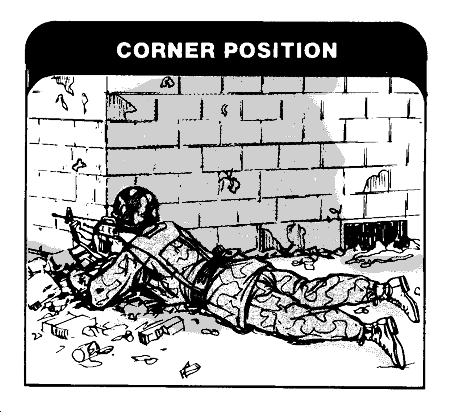
WALLS
When firing from behind a wall, fire around it if possible, not over it.
Firing around it reduces the chance of being seen by the enemy. Always stay low,
close to the wall, and fire from the shoulder that lets you stay behind cover.
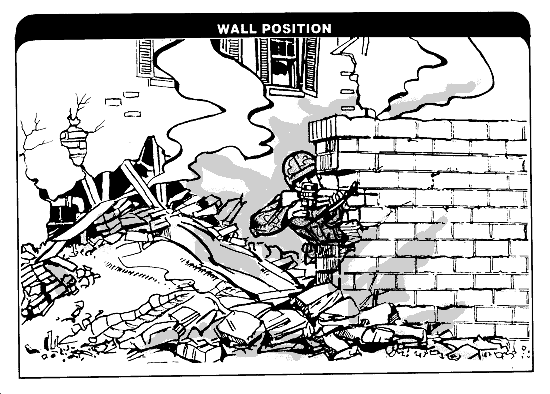
WINDOWS
When using a window as a fighting position, do not use a standing position,
as it exposes most of your body. Standing may also silhouette you against a
light-colored interior wall or a window on the other side of the building. Do
not let the muzzle of your rifle extend beyond the window, as that may give away
your position. The enemy may see the muzzle or the flash of the rifle.
The best way to fire from a window is to get well back into the room. That
prevents the muzzle or flash from being seen. Kneel to reduce exposure.

To improve the cover provided by a window, barricade the window but leave a
small hole to fire through. Also barricade other windows around your position.
That keeps the enemy from knowing which windows are being used for fighting
positions. Use boards from the interior walls of the building or any other
material to barricade the window. The barricade material should be put on in an
irregular pattern so that the enemy cannot determine which window is being used.
Place sandbags below and on the sides of the window to reinforce it and to
add cover. Remove all the glass in the window to prevent injury from flying
glass.
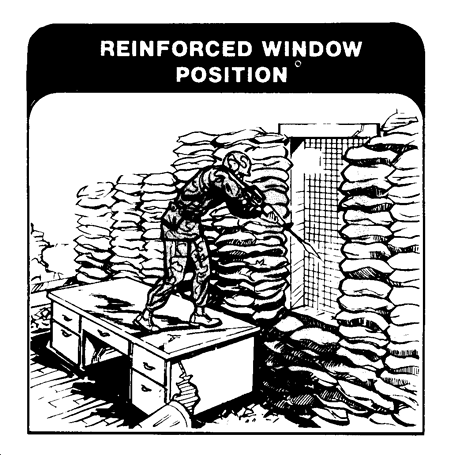
PEAKS OF ROOFS
A peak of a roof can provide a vantage point and cover for a fighting
position. It is especially good for a sniper position. When firing from a
rooftop, stay low and do not silhouette yourself.
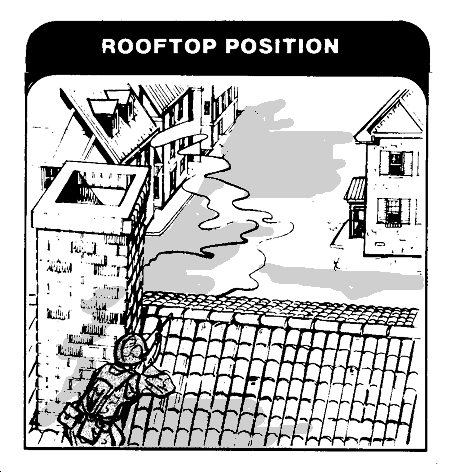
A chimney, smokestack, or any other structure extending from a roof can
provide a base behind which you can prepare a position. If possible, remove some
of the roofing material so that you can stand inside the building on a beam or
platform with only your head and shoulders above the roof. Use sandbags to
provide extra cover.

If there are no structures extending from a roof, prepare the position from
underneath the roof and on the enemy side. Remove enough of the roofing material
to let you see and cover your sector through it. Use sandbags to add cover.
Stand back from the opening and do not let the muzzle or flash of your rifle
show through the hole. The only thing that should be noticeable to the enemy is
the missing roofing material.

LOOPHOLES
A loophole blown or cut in a wall provides cover for a fighting position.
Using loopholes reduces the number of windows that have to be used. Cut or blow
several loopholes in a wall so the enemy cannot tell which one you are using.
When using a loophole, stay back from it. Do not let the muzzle or flash of your
rifle show through it.

To reinforce a loophole and add cover, put sandbags around it. If you will be
firing from a prone position on the second floor, put sandbags on the floor to
lie on. That will protect you from explosions on the first floor. Use a table
with sandbags on it or some other sturdy structure to provide overhead cover.
That will protect you from falling debris.
























